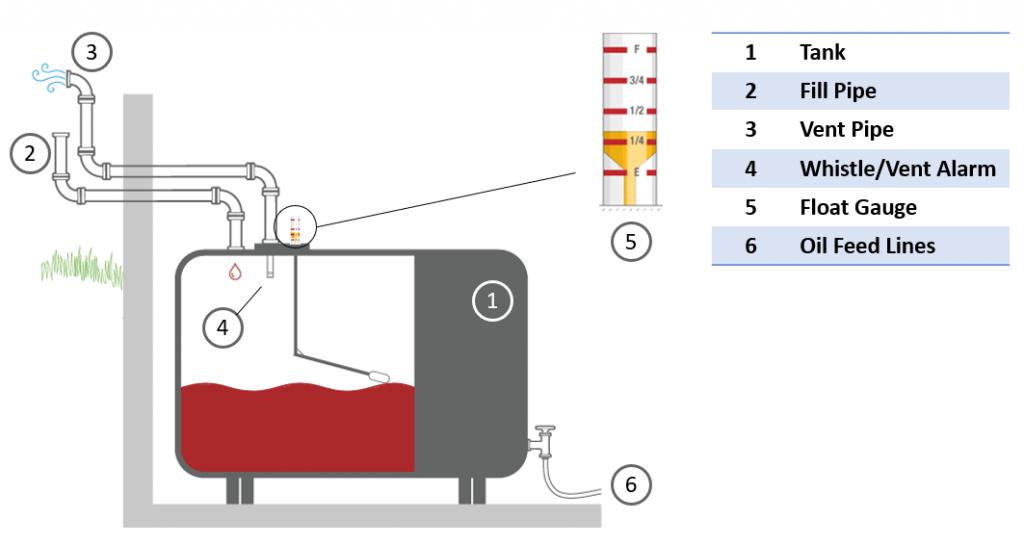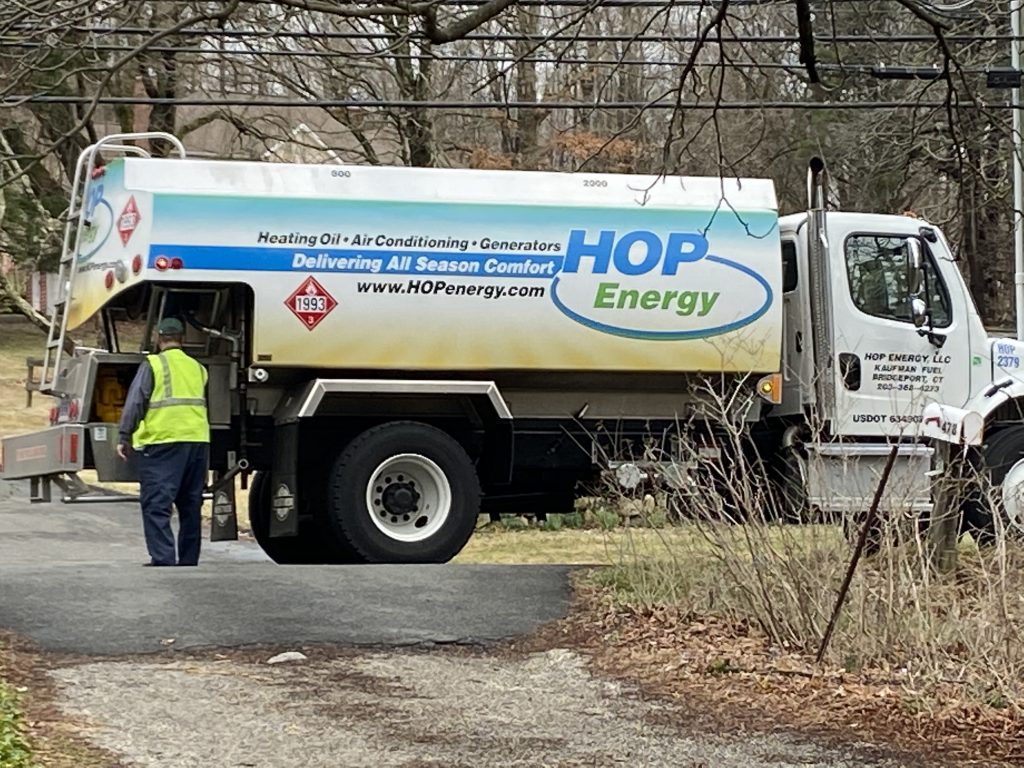If you live in the northeast and have an oil-heated house, you may be wondering how your fuel oil tank gets filled. Since most oil tanks are located indoors, and the delivery driver cannot access the basement, the delivery must be made without the driver entering the home. To facilitate this, oil tanks are fitted with a fill pipe and a vent pipe to allow the oil tank to be filled from the outside.
In this post, we will introduce the various components of a fuel oil tank and walk you through what’s involved in the home heating oil delivery process!
What are the Components of a Heating Oil Tank?
Oil tanks come in a variety of shapes and sizes, and can be found inside the house or outside. Occasionally, oil tanks are buried in the ground, but the components below are consistent with most tanks.
The fill pipe extends from the top of the oil tank, through the exterior wall, and outside of the house. There is a cap that screws in place to keep the fill pipe closed. The vent pipe also extends up and out of the house, and allows air to escape as the oil tank is being filled. It also allows air into the tank as the oil is being used.
The whistle (also known as a ‘vent alarm’) is the most critical component when it comes to filling an oil tank from outside. The whistle is located at the bottom of the vent pipe and hangs approximately 6” down from the top of the oil tank. As air is forced out of the tank by the incoming oil, it blows by the whistle, creating a sound that the driver hears outside. Once the oil level rises to the level of the whistle, the sound is muffled, and the driver knows to stop pumping, as the tank is full.

How to Set the Amount for your Home Heating Oil Delivery
Before the driver begins the home heating oil delivery, he or she needs to determine whether to ‘fill’ the oil tank (keep pumping until the whistle stops), or just deliver a predetermined amount. Since many customers prefer to know exactly what they’re spending, many will order 100 gallons or 150 gallons at a time. In this case, the driver will set the pump to stop once that amount has been delivered. They will still listen for the whistle to ensure that the oil tank is not over-filled.
If you’re wondering how much heating oil to order for your fuel oil tank, consider installing a Smart Oil Gauge. This will tell you not only how much oil is in the tank at any given time, but also how much home heating oil can be delivered.
Connecting the Hose to the Fill Pipe
Once they have determined how much heating oil to deliver, they must find the fill pipe. Since this can be located anywhere at the house, remember to give instructions when placing your heating so they know where to find it!
Once they locate the fill pipe, they will pull the hose from a reel on the back of the truck. If you have a small driveway, the driver may opt to park in the road and pull the hose all the way to the fill pipe. If you have a larger driveway or your house is too far from the road for the hose to reach, expect the driver to pull in to get close to the fill pipe. Once they’re at the fill pipe, they will remove the cap, and screw the end of the hose in place to secure the hose to the house.

Pumping Heating Oil into the Fuel Oil Tank
Once the hose has been attached to the fill pipe, the driver is ready to start pumping the heating oil into the tank. There is a lever on the nozzle that allows the driver to start the flow of heating oil into the tank. They will typically begin pumping slowly by only partially opening the nozzle. This will allow them to listen for the vent alarm and ensure the oil tank is not full before pumping too much oil into the tank. Since these trucks pump at a rate as high as one gallon per second, an oil tank can be overfilled very quickly if the driver is not careful!
After the driver hears the whistle, they’re able to turn up the flow on the pump and fill the tank. If the customer ordered a specific number of gallons, the pump will shut off automatically once that amount has been pumped.
If the customer has ordered a ‘fill’, then the driver will continue pumping until he hears the whistle sound stop. At this point, he will shut the pump off.
Printing the Home Heating Oil Delivery Ticket
Once the pump as stopped, the driver removes the nozzle from the fill pipe and reinstalls the cap. They retract the pump back to the truck, and prepare the delivery ticket.
A delivery ticket will be printed to include the heating oil company information, as well as a starting volume (0.00 gallons), and an ending volume that shows how much oil was delivered. There will also usually be additional information such as the price paid per gallon, delivery date, etc.
In-Ground Oil Tanks
In-ground oil tanks are less and less common these days but are still out there. They also often do not have a vent alarm / whistle to alert the driver when the oil tank is full. If this is the case, the driver will typically use a stick to measure the amount of oil in the tank before making the delivery. With this knowledge, and knowing the size of the heating oil tank, they will know how much oil can safely be delivered.
If the driver and homeowner do not know what size oil tank is buried, then the driver will take a measurement of the oil level, pump a certain amount of oil (e.g. 100 gallons), then take another measurement. They will then compare the two levels on a tank chart to determine what size oil tank it is.
Some drivers also carry a specially-designed vent/fill pipe that can be inserted into the fill pipe. It features a vented pipe that extends just past the fill pipe into the top of the buried oil tank. The truck’s nozzle is able to thread onto this, and pump oil by the vent section. A whistle sound will be created until the oil tank is full, at which point the driver knows to stop pumping oil.
Summary: Filling a Home Heating Oil Tank
Since most home heating oil delivery drivers cannot see the oil tank while making a delivery, they must rely on the vent alarm / whistle to know the fuel oil tank is safely being filled. As long as they hear that whistle making noise, they know that air is escaping from the vent pipe, and the oil tank is not full.
If you’d like to see a heating oil tank get filled in-person, go on outside next time your heating oil truck arrives! Most of the drivers I’ve met are super friendly and always willing to explain how everything works.
Happy heating,
Steve



